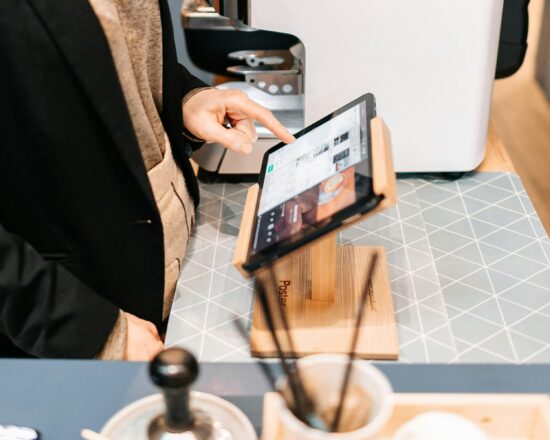People don’t like to wait in line. When checkout takes too long, it creates frustration for customers and pressure for the staff. That kind of stress can lead to lost sales, shorter visits, and a less enjoyable experience overall. Businesses that make checkout quick and smooth often see better customer satisfaction and more return visits.
It doesn’t take a complete overhaul to make checkout more efficient. Small adjustments in process and tools can create big wins when done right. When speed meets ease, it’s not just about moving faster–it’s about making the whole experience feel better for everyone involved.

Source: Unsplash (CC0)
Understand what slows customers down
Every checkout experience has a few potential slow spots. It could be an outdated register, a confusing payment process, or a line that builds during busy hours without a good way to manage it. The first step in fixing it is paying attention to where customers tend to get stuck.
Sometimes, it’s about how employees are trained or how the space is organized. Watching how things go during peak times can show a lot about what’s working and what isn’t. When small friction points are removed, everything flows more smoothly.
Offer multiple ways to pay
Customers now expect flexibility in how they pay. Some still use cards, others prefer digital wallets, and many like the tap-and-go experience. Giving people those options saves time and avoids that awkward moment where someone fumbles for a method that isn’t accepted.
It’s smart to keep the process consistent across payment types. When systems are fast and easy to use, regardless of how the customer wants to pay, transactions move quickly, and people walk away feeling good about the experience. Speed isn’t just about hardware; it’s also about convenience.
Use the right tools for quicker checkouts
Technology has changed the checkout game. Using a smart terminal for faster checkouts can shave seconds off every transaction, which adds up quickly during a busy day. These terminals often combine payment processing, receipt printing, and customer interaction in one device, which reduces clutter and speeds things up.
They also tend to integrate with other systems like inventory or customer rewards, which means less time toggling between screens or asking repeat questions. When the checkout setup is well-designed, it helps both staff and customers feel more confident and less rushed.
Keep lines short with better flow
The physical layout of the checkout area can affect how fast people move through it. If customers are crammed into a corner, waiting for unclear directions, or stepping around obstacles, it slows everything down. Even simple changes like clearer signs or an extra payment station during peak times can reduce the wait.
Creating a logical, organized path to the register helps the whole space feel calmer. Staff can focus on what matters, and customers can see where they need to go. A checkout that flows well creates less stress and moves people through faster without needing to rush anyone.

Source: Unsplash (CC0)
Don’t forget the mobile experience
Mobile shopping isn’t just for online-only brands. Many physical businesses these days now accept orders, reservations, or payments through mobile devices, and that convenience can carry over into the checkout process. When customers can pay from their phones or scan a code to complete their transaction, it eliminates the need to wait in line at all.
Integrating mobile-friendly options also helps reduce congestion at the counter. It gives people a faster way to check out when they’re in a hurry, which keeps the flow steady and the experience pleasant. Businesses that offer mobile checkout options tend to attract customers who value speed and flexibility.
Train staff to be confident and quick
Technology helps, but the people running the checkout make a huge difference. Staff who are confident, well-trained, and ready to solve problems quickly can turn even a long line into a smooth experience. That kind of energy keeps things moving and makes customers feel like they’re being taken care of.
Training doesn’t need to be complicated, just focused. It’s helpful to walk employees through common scenarios, quick responses, and time-saving tips. Empowered staff feel better about their role and tend to work faster without cutting corners or causing confusion.
Make it easy for customers to self-check
Offering a self-checkout option can take pressure off the main register during peak hours. People who prefer to move at their own pace or skip the interaction altogether often love having this choice. Even one or two self-checkout stations can significantly reduce wait times.
The key is to make it simple. If the process is easy to follow and help is nearby in case something goes wrong, customers will use it with confidence. Businesses that give people this level of control often see higher satisfaction and fewer complaints about delays.
Offer fast checkout solutions for a small business
You don’t have to run a huge operation to make checkout faster. There are easy-to-use, affordable tools that work even for a small business looking to speed things up. Cloud-based point-of-sale systems, mobile card readers, or tablet checkouts can be just as effective as larger setups.
It’s not about how big the system is, but about how well it fits the business’s flow. Finding something that supports the daily rhythm and matches how customers prefer to pay can make a huge difference in how smooth the checkout feels from start to finish.
Review and improve regularly
Once the basics are in place, it’s a good idea to review what’s working. Gathering feedback from staff and customers can reveal small tweaks that make things even faster. Business owners don’t have to make huge changes all the time; just staying flexible helps keep things efficient.
Even small adjustments can make a big difference when they’re based on real experience. Maybe it’s shifting peak staffing hours or moving the receipt printer to a better spot. By staying open to change, businesses can keep improving without disrupting their core routines.
Fast checkouts aren’t just about speed; they’re about making the entire experience smoother, simpler, and more pleasant. When businesses invest in better tools, smarter layouts, and confident staff, they save time and leave customers feeling happier. And in today’s world, that kind of satisfaction builds real loyalty.